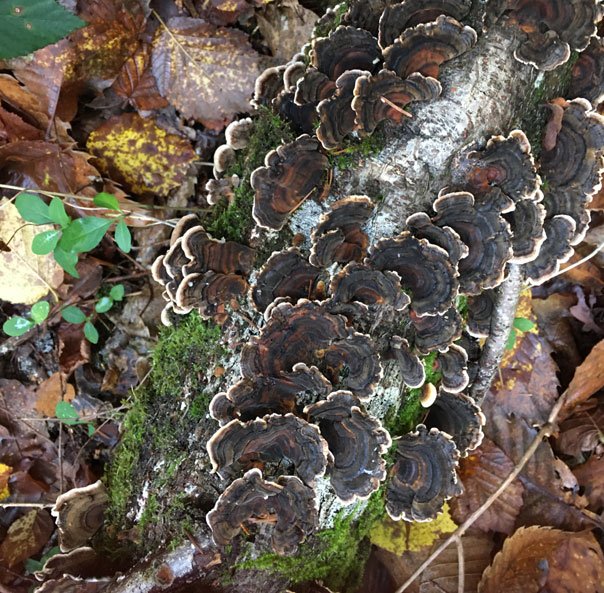Mushrooms or is it Fungi?
The First thing you should know about fungi, is that they are literally everywhere. They are in the Antarctic well below freezing. They are under coral reefs. They are found in the upper atmosphere and they’ve even been found 45km (25 miles) above the surface of our earth. Fungi are in every aspect of our lives, sometimes visible but often well out of sight. In fact, you are covered in fungi. It is likely that you have over 130 of species of fungi growing on your skin in your hair and even underneath your fingernails and toenails. They are all part of your personal biome. They are not just on you, they are also inside you.

Take a deep breath ….. You have just inhaled a breathful of fungal spores! You are doing this constantly. In fact an average adult will inhale about 50,000 spores every single day of their lives. Thankfully our immune system is very capable of breaking down these spores and stopping them from infecting your lungs.
So we live in this soup of other living things but we pretend that we are clean and somehow separate. In reality we are all deeply connected to the living world around us on every level.
What are Fungi?
A fungus (plural: fungi) is a type of eukaryotic organism belonging to the kingdom Fungi, alongside plants, animals, protozoa, and monera. Fungi are forms of yeast, molds, truffles, and mushrooms.
All lifecycles of fungi depends on the species. The mushroom (that you eat) is one small part of the lifecycle of a macro fungi (any fungi that produces a mushroom). A mushroom produced spores which germinate, which then creates Hyphae which become the matted web of mycelium. It’s this mycelium that consumes nutrients in soil or wood and uses these nutrients to produce more mushrooms so that it can once again spread its spores.
So whilst the cycle can continue with the parent fungus for most macro fungi, it can also start anew, wherever spores land. Most people don’t realise that its the mycelium thats the engine of the fungi. The mycelium performs all the exploration, digestion and exploration. It’s all about the mycelium.
The fruiting bodies of mushrooms exist for one reason only, to spread the genetics of the fungus via its spores. Some mushrooms are very tasty, some are very big and some small, but the golden rule always applies. If a mushroom has some sort of feature like size, tastiness, shape or colour, then that feature allows the fungi to be more successful. A mushrooms features exist purely to spread spores. There is a purpose in their beauty.
May the spores are with you
In some ways spores are a little like microscopic seeds. They provide a method for fungi to spread their genes and to reproduce sexually. They are so small, they can be spread by really subtle air currents. They are so tough they can lie dormant for many years.
If a spore lands on a certain material or substrate, and all the conditions are right, they will germinate and grow microscropic threads – the Hyphae – which then grows into a mass of Mycelium. Once you have a mycelium, this is where it gets interesting. Mycelium has evolved to break down the materials around them and convert them to food. It can also use these chemicals to defend itself and attack other organisms as well as make antibiotics and flavours.
As the mycelium develops, it will run out to explore its environment as quickly as possible. If its healthy and vigorous, it will grow lots of long strong hyphae to cover the maximum amount of ground in the shortest time possible. This is the running or colonisation phase. This ensures that it can out compete any competitors. Once the fungi it satisfied that it has covered enough area to survive, it will start to digest the material it has climb over and around, the consolidation phase. Its goal is to run through its preferred food source and then spend time digesting it, in order to store up enough energy for the next phase.
Fruiting Mushrooms
When conditions are just right, the mycelium will produce a number of small buds called Hyphal knots. Each hyphall knot will start to form a ball creating Primordia. A biological term of something in the early stages of growth. In this case the mushrooms beginning to form. As it continues, you will see tiny clusters of stalagtites or pins, which is why this is called “Pinning”. This is where the fruit really starts to grow, and you can actually see dozens of baby mushrooms. This is one of the most critical points in the growth process. The Pinning needs to be in the perfect environmental conditions so that the pins are nursed through that first stage, ensuring they thrive and fruit.
Mushrooms are quite fragile and don’t last for long. They don’t have a particularly strong immune system and the fungi doesn’t waste much energy defending them.
Spores
How mushrooms produce spores is another long and complex tale. It’s another amazing aspect of the world of fungi. In summary, the mushroom shoots its spores as hard as it can to give them the best chance of distribution. Some species of mushroom spore together in pulses. Despite this effort, they often don’t get very far, usually only 30 feet or so at best. To overcome these odds, a single mushroom will produce over 30,000 spores per second! So with that number being released, some of the spores will get away. Spores have been found in just about any environment on earth – so wherever you go.
